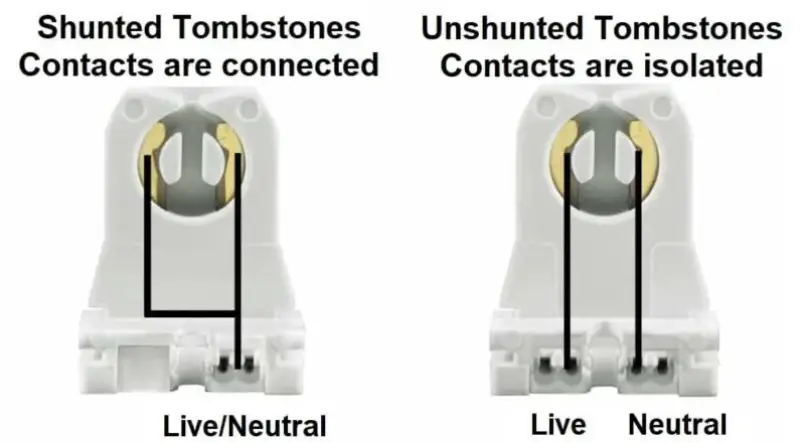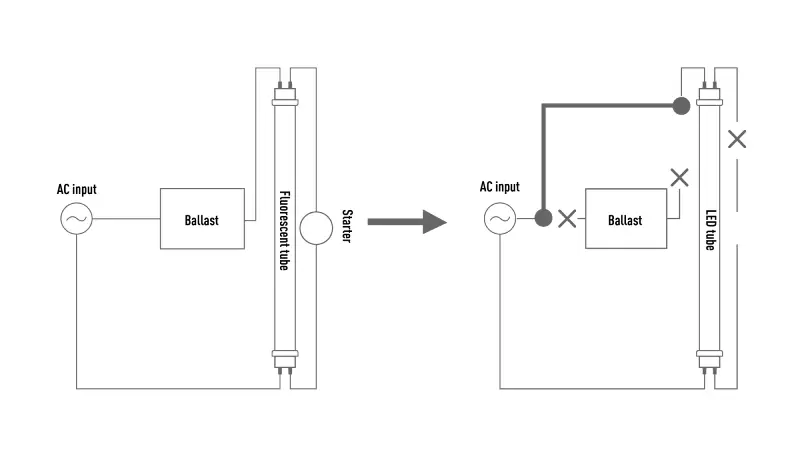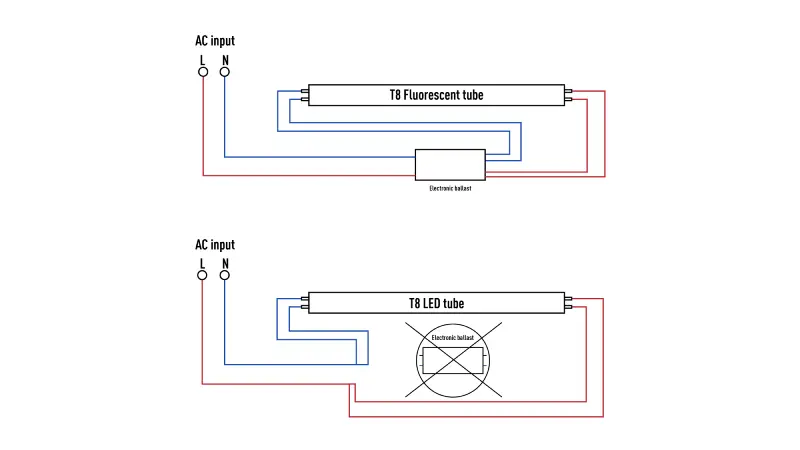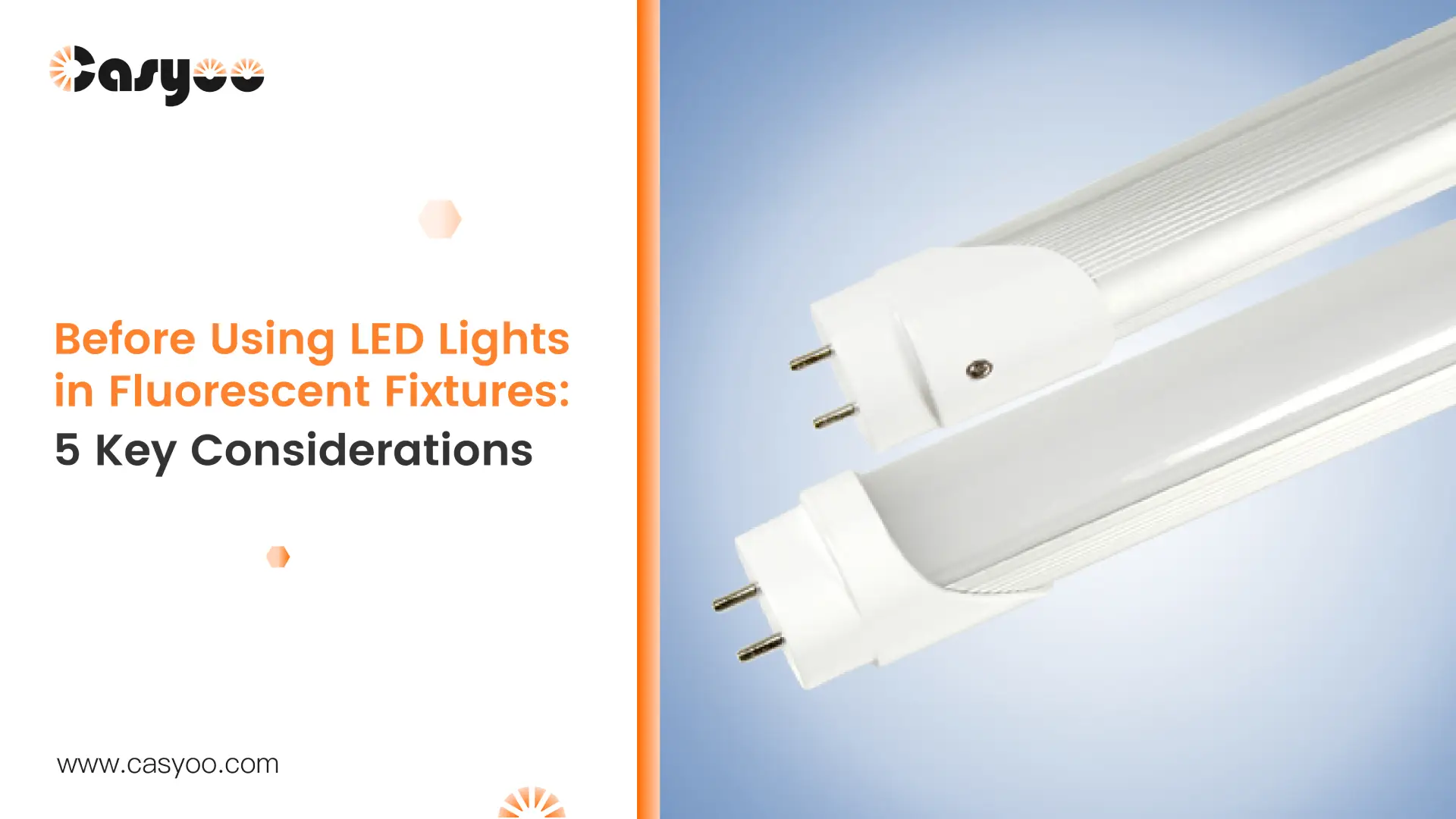The ban on fluorescent lamps is gradually being implemented, and more and more people are starting to consider replacing fluorescent lamps with more efficient LED lamps. Is this a good decision? And is replacing fluorescent lamps with LED lamps just a matter of removing and installing the lamps? In fact, replacing fluorescent lamps with LED lamps is more complicated than you think, as there are more points to pay attention to. Make sure to read our article before using LED lights in fluorescent fixtures for a safe and smooth upgrade!
1. Is it worth replacing fluorescent lights with LED ones?
Let’s compare the advantages and disadvantages of fluorescent lamps and LED lamps.
- Efficiency: The luminous efficiency of fluorescent lamps is usually 50-60lm/w, while the efficiency of most LED lamps can reach 100 lm/w. The actual power consumption of a 36W fluorescent lamp is 44W because the ballast will consume 8W. And the lumen it can emit is about 420. LED lamps can reach a brightness of 1300 lm with only 16W.
- Lifespan: Fluorescent lamps produce visible light through the discharge of mercury vapor, which excites the phosphors on the lamp shade. The substance in the tube that emits electrons will progressively deteriorate over time, eventually leading to the lamp’s failure. Conversely, LED lights contain LED chips, which can transform electricity directly into visible light. This makes them emit brighter light, lower heat, age less slowly, and have a longer lifespan.
- Color rendering index(CRI): The color rendering index of fluorescent lamps can only reach 80 at most, while LED lamps can generally reach 80-90, or even higher. LED lamps can perfectly restore the color of objects like sunlight.
- Compared with LED lamps, fluorescent lamps have other disadvantages, such as the need for high voltage when turned on, which is not very safe to use. Once discarded, the mercury in fluorescent tubes will pollute the environment.
2. 4 types of LED tubes that can replace fluorescent lights
LED tubes are classified into four types under the UL standard: Type A, Type B, Type C, and Type A+B.
- An LED tube with an integrated driver power supply is referred to as a type A tube. The power supply is compatible with the fluorescent lamp ballast. When replacing a tube, there is no need to modify the existing construction. It can directly replace the traditional T5 and T8 fluorescent lamps, and the installation cost is very low. The certification standard for Type A tubes is UL1993+UL8750.
- Type B tubes have built-in driver power supplies and leakage detection modules, which can be directly adapted to the industrial-frequency AC power grid. When installing the tube, you need to short-circuit or bypass the ballast. The certification standard for Type B tubes is UL1993+UL8750+UL1598C.
- A Type C lamp is an LED lamp that is driven by an external DC power source. While installing, you need to replace the ballast inside the lamp with an external driver. The certification standard for Type C lamps is also UL1993+UL8750+UL1598C.
- Type A+B lamp refers to an LED lamp with a built-in driver power supply, which is compatible with the ballast. The lamp can also work with direct AC power supply. Therefore, there is no need to change the original structure and circuit when replacing the lamp. The certification standard for Type A+B lamps is UL1993+UL8750+UL1598C. The lamps need to be marked with UL certification and listed identifiers at the same time.
Installing Type B lamps is relatively complicated as the lamp needs to be modified. As for Type A lamps, even though they can work with the original structure, when the ballast breaks down, the lamp needs to be replaced as well. A+B lamps can better meet the needs of most users, but it is more costly.
3. Do you need to change the tombstones when using LED lights in fluorescent fixtures?
There are two main types of lamp sockets: shunted and non-shunted. The two pins of the shunted tombstone are connected, and current flows through the entire circuit. For the non-shunted tombstone, one pin is attached to the live wire and the other to the neutral one. Different types of LED lamps need different tombstones. The corresponding matching of lamps and sockets is shown in the following table, but we recommend communicating with your supplier to make it clear what type of tombstone is required.

| LED type | Connection type | Socket |
| Type A | Dual end | Shunted or non-shunted |
| Type B | Single end | Non-shunted |
| Dual end | Shunted or non-shunted | |
| Type A+B | Single end | Non-shunted (Ballast bypass with rewired sockets) |
| Dual end | Shunted or non-shunted (Plug-and-play with unmodified fixture) |
4. How do I use LED lights in fluorescent fixtures?
Most of the fluorescent lamps on the market are replaced by type A and type B LED tubes, and few people use type C LED tubes. Type A is plug-and-play, so it requires no modifications to the original circuit. Type A+B is the same. Below are the specific steps to replace fluorescent lamps with type B LED tubes:
① Cut off the power.
② If the original fluorescent lamp uses an inductive ballast, remove the starter and ballast. If the original fluorescent bulb has an electronic ballast, you only need to remove it because there will be no starter in the circuit.
③ Connect the live and neutral wires to the two ends of the light. (If it is a single-ended lamp, connect them to the two pins of one end of the lamp.)
Note:
① Pay attention to distinguish whether the lamp you purchased is single-ended or double-ended. If you connect it incorrectly, there will be a risk of accidents.
② Before operation, make sure the power is off for your safety.
③ It is best to operate under the guidance of a professional electrician.


5. Cost of replacing fluorescent lights with LED ones
The cost of replacing fluorescent lights with LED lights is mainly the purchase of the LED lights and the labor costs of rewiring the circuits. For LED lights that do not require rewiring, there will be no labor costs. LED lights cost about 2-3 times as much as fluorescent lights, but they can save a lot of operating costs.
Adopting LED lighting can result in significant cost savings for households. Because of their remarkable efficiency, LED lights can produce brighter light while using less energy. According to a Consumer Federation of America (CFA) poll, if a household replaces at least 20 fluorescent lights with LED ones, they might save roughly $1,000 on energy costs over a ten-year period.
You won’t have to buy replacements for LED lights as frequently as fluorescent lights. Fluorescent lights need high voltage to start working, which determines that they will burn out frequently. Fluorescent lamps need to be replaced after an average of 5,000-8,000 hours, while LEDs have a lifespan of 50,000 to 100,000 hours.
Conclusion
In the long run, replacing fluorescent lamps with LED lamps is definitely the right choice. It is not only because fluorescent lamps will be banned in the near future, but also because LED lamps are indeed more worth it. In this article, we specifically introduce what you need to pay attention to if you want to use LED lights in fluorescent fixtures. From deciding the types of LED lamps to the specific replacement operations, you must know the specifications of both LED lamps and fluorescent lamps clearly. If you want to do it yourself, you should keep communicating with your supplier and electrician and replace the lights under their guidance. Visit Casyoo to learn more about LED lamps!




